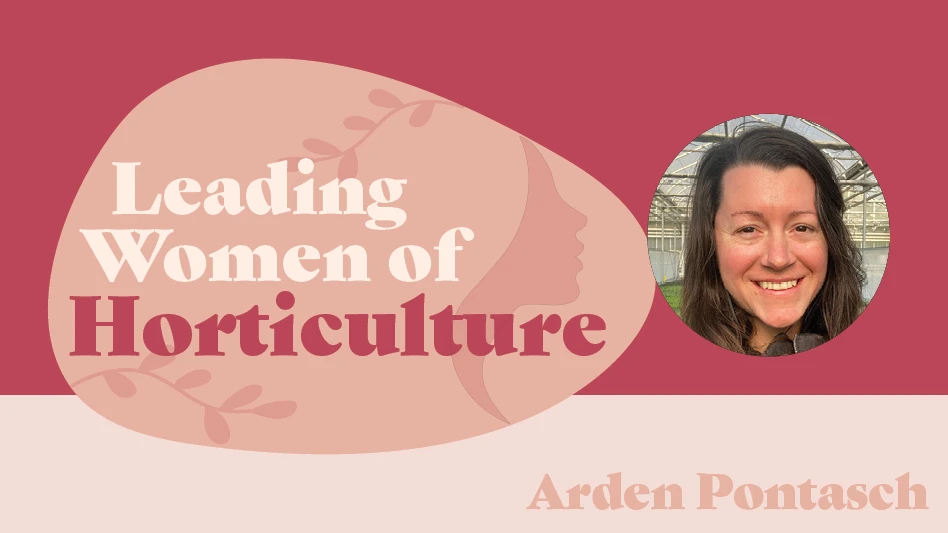 Plastic has been the predominant container material in the U.S. green industry because plastic containers are available in many sizes, shapes, and colors and are relatively inexpensive. Currently, production of ornamental plants consumes an estimated 1.66 billion pounds of plastic every year (Figure 1). The sheer volume of plastic consumption poses many problems, from limited access to recycling centers, high collection costs, liability for poorly sanitized containers, and chemical contamination concerns. Not surprisingly, 98 percent of used plastic containers are disposed of in landfills. Consumers are questioning the use of plastic products as a sustainable practice in a truly “green” industry, and some consumers are even willing to pay a premium for non-plastic or recyclable containers. Meeting this consumer interest gives growers and retailers an opportunity to offer more eco-friendly products.
Plastic has been the predominant container material in the U.S. green industry because plastic containers are available in many sizes, shapes, and colors and are relatively inexpensive. Currently, production of ornamental plants consumes an estimated 1.66 billion pounds of plastic every year (Figure 1). The sheer volume of plastic consumption poses many problems, from limited access to recycling centers, high collection costs, liability for poorly sanitized containers, and chemical contamination concerns. Not surprisingly, 98 percent of used plastic containers are disposed of in landfills. Consumers are questioning the use of plastic products as a sustainable practice in a truly “green” industry, and some consumers are even willing to pay a premium for non-plastic or recyclable containers. Meeting this consumer interest gives growers and retailers an opportunity to offer more eco-friendly products.
Available choices
 Growers have a range of alternative container types to select from, each with slightly different characteristics (Figure 2). Plantable containers can be planted directly into the soil by the end user. These containers are intended to withstand watering and handling during relatively short-term production (approximately 12 weeks to 12 months depending on climate, production practices, and container material). Plantable containers eliminate container removal and disposal costs and reduce the time required for transplanting and cleanup at installation by 20 percent, which can be a big boon to landscape customers. Examples of plantable container materials include: composted cow manure, paper, peat, rice hulls, rice straw, spruce fibers, wheat, or wood pulp. A second container type is compostable containers. Compostable containers are removed at installation and the containers are either composted in backyard or industrial facilities, which consumes energy. Most bioplastics, as well as solid rice hull, keratin, and thick-walled paper and/or cardboard-based containers intended for a production duration of approximately a year, fall into this category. It should be noted that some containers marketed as compostable did not meet degradation standards during our trials but for simplicity we refer to them as compostable. Containers made from recycled plastic, water and soft drink bottles blended with biodegradable natural fibers, such as cotton, jute, vegetable fibers or bamboo are neither plantable nor compostable but disintegrate slowly. These containers have a reduced carbon foot print compared to plastic containers made entirely from petro-chemicals. Because not all of these containers are made from 100 percent biodegradable materials we refer to them as alternative containers rather than biocontainers.
Growers have a range of alternative container types to select from, each with slightly different characteristics (Figure 2). Plantable containers can be planted directly into the soil by the end user. These containers are intended to withstand watering and handling during relatively short-term production (approximately 12 weeks to 12 months depending on climate, production practices, and container material). Plantable containers eliminate container removal and disposal costs and reduce the time required for transplanting and cleanup at installation by 20 percent, which can be a big boon to landscape customers. Examples of plantable container materials include: composted cow manure, paper, peat, rice hulls, rice straw, spruce fibers, wheat, or wood pulp. A second container type is compostable containers. Compostable containers are removed at installation and the containers are either composted in backyard or industrial facilities, which consumes energy. Most bioplastics, as well as solid rice hull, keratin, and thick-walled paper and/or cardboard-based containers intended for a production duration of approximately a year, fall into this category. It should be noted that some containers marketed as compostable did not meet degradation standards during our trials but for simplicity we refer to them as compostable. Containers made from recycled plastic, water and soft drink bottles blended with biodegradable natural fibers, such as cotton, jute, vegetable fibers or bamboo are neither plantable nor compostable but disintegrate slowly. These containers have a reduced carbon foot print compared to plastic containers made entirely from petro-chemicals. Because not all of these containers are made from 100 percent biodegradable materials we refer to them as alternative containers rather than biocontainers.
Production trials
As alternative containers gain popularity, growers and retailers question what to expect from them during a production and marketing cycle. Researchers from Arkansas, Illinois, Kentucky, Michigan, Mississippi, Tennessee, Texas, Utah and West Virginia have been working on a USDA Specialty Crop Research Initiative project to evaluate alternative containers during and after greenhouse production and above ground and pot-in-pot nursery production. Containers tested during greenhouse production and subsequently tested during landscape establishment include: recycled paper and cardboard (Western Pulp, Fertil Pot) cow manure (CowPot), straw (StrawPot), rice hull (NetPot), peat (Jiffy-Pot), coir and bioplastic (SoilWrap). The above ground nursery containers (1-gallon) tested were: recycled paper and cardboard (Western Pulp, Kord Fiber Grow), chicken feather-based keratin, coir and recycled plastic (Root Pouch) and containers tested for pot-in-pot production were two types of recycled paper and cardboard (Western Pulp, Kord Fiber Grow). Researchers examined water use and root zone temperature associated with alternative containers; assessed container and plant performance both during production and after planting in the landscape; tested container strength, durability, and appearance; and conducted economic and environmental analyses of production using alternative containers. The following represents a portion of the results. Comprehensive, detailed research results are available in an alternative container special issue of HortTechnology published February 2015.
 Numerous herbaceous and woody plants species were grown in alternative and black plastic containers in greenhouses and nurseries with little or a positive effect on growth and plant quality at most test locations. The porous nature of wood pulp and fabric containers allowed evaporative cooling, reducing potting substrate temperature by around 11ºF during above ground nursery production compared to black plastic containers, which increased plant survival under hot summer conditions. Not surprisingly, porous alternative containers used on average 20-40 percent or more water, which could erode the economic feasibility and environmental sustainability of alternative containers particularly in regions with perpetual water shortages (Figure 3). Keratin containers, which are slightly smaller and lighter in color used less water than plastic.
Numerous herbaceous and woody plants species were grown in alternative and black plastic containers in greenhouses and nurseries with little or a positive effect on growth and plant quality at most test locations. The porous nature of wood pulp and fabric containers allowed evaporative cooling, reducing potting substrate temperature by around 11ºF during above ground nursery production compared to black plastic containers, which increased plant survival under hot summer conditions. Not surprisingly, porous alternative containers used on average 20-40 percent or more water, which could erode the economic feasibility and environmental sustainability of alternative containers particularly in regions with perpetual water shortages (Figure 3). Keratin containers, which are slightly smaller and lighter in color used less water than plastic.
Alternative nursery containers had good durability under typical growing conditions, and even after overwintering. In other studies, biocontainers used for more than 6 to 8 weeks production in the greenhouse had algal and/or fungal growth and became fragile (e.g., molded fiber, cow manure, peat), reducing aesthetic qualities, and shipping and handling properties. These containers may be best suited for short-term greenhouse production and subsequent landscape planting rather than retail sales. This is the trade-off between durability and biodegradability, but one that environmentally conscious producers may be willing to accept.
Following some of the production trials, ‘Sunpatiens Compact Magenta’ New Guinea impatiens, ‘Luscious Citrus’ lantana, and ‘Senorita Rosalita’ cleome grown in plantable containers were installed in the landscape. At the end of the season, manure-based containers had nearly completely degraded (88 percent), while straw, wood fiber, soil wrap, peat, coir, and rice hull degraded 18-47 percent. Even at the low end of the range of container decomposition, plantable containers did not hinder plant establishment after planting into the landscape. In isolated cases plants in straw and coir containers were smaller than plants in other containers but still grew to an appropriate size in the landscape.
Container type is one of the most visible and recognizable sustainable changes that growers and retailers can make. However, depending on petroleum prices, alternative containers can be more expensive, typically 10 percent to 50 percent more than their plastic counterparts. An increased cost means that growers must be able to realize a price premium or reduce production costs. A recent study showed that consumers found plants grown in 4-inch recyclable, plantable, and non plastic (i.e. compostable) containers to be worth an additional $0.16, $0.12, and $0.23, respectively. Certain segments of the population will pay a price premium greater than those listed, so depending on the end consumer demographic the reward for adopting alternative containers can be greater. Other studies report an increased customer demand for biodegradable containers compared to the traditional plastic container. Similar to results from groundcover production in Quonset huts and some of our greenhouse studies, John Ruter at the University of Georgia found that ‘Aztec Gold’ daylily grown in fiber containers produced more fans than those grown in plastic containers and ‘Otto van Luyken’ laurel was 53 percent larger and survival was double in a fiber container compared to a black plastic container. Growers, especially those in Southern locations, may want to try porous alternative containers to see if they shorten the production duration and/or improve survival, increasing the cost effectiveness of alternative containers.
Consumers are becoming increasingly interested in the green industry’s impact on the environment and the impact of their own purchasing decisions. Using containers made of alternative materials can be good for production and for the bottom line. As with plantable containers for landscape contractors or evaporative cooling in hotter locations, there may even be some value added aspects of alternative containers. However, growers must consider the potential increase in container cost, inability to reuse, and increased water use for some containers and any changes in their production that may need to be made to successfully integrate alternative containers.
The authors wish to recognize the USDA (Specialty Crops Research Initiative Grant number 2010-01190) and their respective land grant institutions for support for the research reported in this article.
Get curated news on YOUR industry.
Enter your email to receive our newsletters.
Explore the March 2015 Issue
Check out more from this issue and find your next story to read.
Latest from Nursery Management
- Trends: Proven Winners 2025 perennial survey shows strong demand
- Online registration opens for the 2025 Farwest Show
- Sustainabloom launches Wholesale Nickel Program to support floriculture sustainability
- Plant breeding as an art
- Society of American Florists accepting entries for 2025 Marketer of the Year Contest
- American Horticultural Society welcomes five new board members
- Get to know Christopher Brown Jr. of Lancaster Farms
- American Floral Endowment establishes Demaree Family Floriculture Advancement Fund





